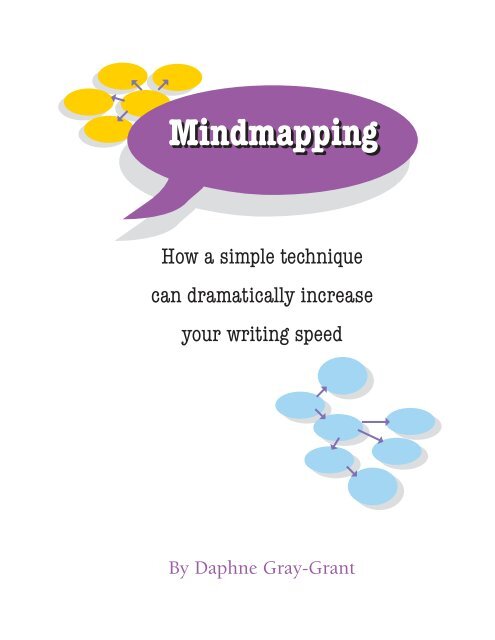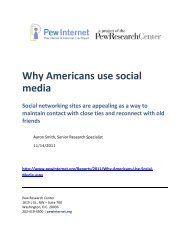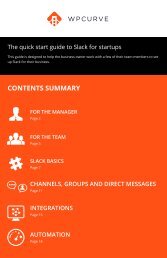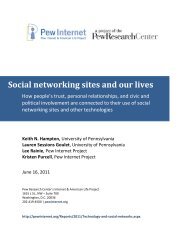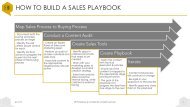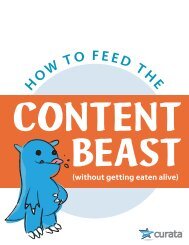Mindmapping
Create successful ePaper yourself
Turn your PDF publications into a flip-book with our unique Google optimized e-Paper software.
<strong>Mindmapping</strong><br />
How a simple technique<br />
can dramatically increase<br />
your writing speed<br />
By Daphne Gray-Grant
Contents<br />
Introduction . . . . . . . . . . . . . . . . . . . . . . . . . . . . . . . . . . . . . . .3<br />
What is a mindmap? . . . . . . . . . . . . . . . . . . . . . . . . . . . . . . . . .4<br />
How can you create your own mindmap? . . . . . . . . . . . . . . . .5<br />
Why do mindmaps work? . . . . . . . . . . . . . . . . . . . . . . . . . . . .8<br />
What people say about mindmapping . . . . . . . . . . . . . . . . . .10<br />
Advanced mindmapping techniques . . . . . . . . . . . . . . . . . . .12<br />
Resources . . . . . . . . . . . . . . . . . . . . . . . . . . . . . . . . . . . . . . . .13<br />
Books<br />
Software<br />
Conclusion . . . . . . . . . . . . . . . . . . . . . . . . . . . . . . . . . . . . . . .15<br />
About Daphne . . . . . . . . . . . . . . . . . . . . . . . . . . . . . . . . . . . . .16<br />
Next steps . . . . . . . . . . . . . . . . . . . . . . . . . . . . . . . . . . . . . . . .17<br />
If you haven’t received this e-book directly from The Publication Coach,<br />
it’s an illegal copy.<br />
http://www.publicationcoach.com © 2006 Daphne Gray-Grant, All Rights Reserved
Introduction<br />
When you sit down to write an article, story or other piece of work, one of two problems often<br />
occurs:<br />
(1) You have dozens of ideas competing for your attention and you don’t know where to begin.<br />
Thoughts flicker through your mind and disappear. Zip – they’re gone! You’re like a child at<br />
the circus – so many lovely, colourful things are competing for your attention, you don’t know<br />
where to focus. As a result, you feel lost and overwhelmed.<br />
OR (more commonly)<br />
(2) You are totally bereft of ideas. You have nothing to say. You despair of ever getting anything<br />
written. As you sit down to write, you feel like a labourer trudging through a muddy field—<br />
it’s as if your boots are being sucked off your feet with each tiresome step you try to take.<br />
These situations are polar opposites – but, interestingly, they lead to the same result. You can’t write.<br />
This report you’re reading describes a technique for getting around both of these problems. It’s<br />
called mindmapping, although it’s sometimes also known as clustering or webbing.<br />
It will help you write faster, have more fun doing it and produce better results. It doesn’t cost a<br />
thing. And it’s easy to learn. So let’s get started.<br />
http://www.publicationcoach.com © 2006 Daphne Gray-Grant, All Rights Reserved 3
What is a mindmap?<br />
If you haven’t seen a mindmap before, you’re probably curious about what one looks like. So, before<br />
talking about the theory, let me show you an actual map. In fact, this is the first one I created for<br />
writing this report.<br />
Adam<br />
Alice<br />
Gabor<br />
Erin<br />
Comments<br />
from users<br />
<strong>Mindmapping</strong><br />
Why it<br />
works<br />
Different<br />
from<br />
outlining<br />
How to do it<br />
Who?<br />
Right brain<br />
Metaphor<br />
Turn paper<br />
sideways<br />
Write FAST<br />
Brainstorming<br />
with oneself<br />
Tony Buzan<br />
Gabriele Rico<br />
“Aha!”<br />
You don’t<br />
have to<br />
finish<br />
Creativity<br />
Don’t exclude<br />
Use colour<br />
Have fun!<br />
As you can see, it’s simply a group of words with circles drawn around them and lines connecting<br />
them to other words.<br />
Now you’re probably wondering how a few words and squiggles on a page could possibly help with<br />
writing. So here’s the secret: mindmaps are personal. This map is meaningful to me because each<br />
word harbours an association for me. And even if you created a mindmap on exactly the same topic<br />
and used exactly the same words (which is pretty unlikely), you would still have different<br />
associations for them.<br />
Like snowflakes and human beings, each mindmap is unique.<br />
http://www.publicationcoach.com © 2006 Daphne Gray-Grant, All Rights Reserved 4
How can you create your own mindmap?<br />
One of the best things about mindmapping is that it’s so simple.<br />
Take a blank piece of 8.5 x 11-inch paper and turn it sideways. (This may sound picky, but it’s<br />
crucial. Turning the paper so it sits landscape fashion will give you more “room” to write all around<br />
your central idea. This will help make your mind feel open and expansive.) If you’re creating a<br />
mindmap for a long piece of writing – such as a book – you might even want to get a large piece of<br />
blank newsprint or butcher’s paper and stretch it across your office or dining room table, so you can<br />
really spread out!<br />
Write your subject or central idea in the middle of the paper. For example, if you’re writing an<br />
article on the advertising campaign for a new cellphone, you might write: “cellphone ad campaign.”<br />
Draw a circle around this phrase or idea.<br />
Now, just let your mind wander. Each time a word or association pops into your head, write it down<br />
and draw a circle around it. Link it to the word/phrase that inspired the thought by drawing a line<br />
to it, as you can see in the example here:<br />
Fred in<br />
Marketing<br />
Ad agency<br />
Who<br />
Creative<br />
concept<br />
Cellphone<br />
ad campaign<br />
Length of<br />
each<br />
campaign?<br />
Bright<br />
colours<br />
Use exotic<br />
animals<br />
TV<br />
What<br />
Newspapers<br />
& magazines<br />
Radio<br />
Whimsical<br />
Billboard &<br />
bus shelters<br />
http://www.publicationcoach.com © 2006 Daphne Gray-Grant, All Rights Reserved 5
If you have lots of ideas, this process will be very fast. If you have only a few ideas, you’ll likely start<br />
slowly (okay, maybe very slowly), but you will pick up speed as you go. But whatever you’re feeling,<br />
be sure to keep these simple rules in mind:<br />
Don’t judge or evaluate. Every idea is acceptable. Just write them all down on the page.<br />
Reassure yourself that if you don’t like some of the ideas, you can always cross them out<br />
later. But “judging” while you’re mindmapping will cause you to choke. Instead, you should<br />
simply write down your thoughts as fast as you possibly can. If you find your mind going<br />
blank, don’t panic! Just keep your pen moving by drawing empty lines, colouring in the<br />
circles or doodling.<br />
Don’t limit yourself to just the facts. The words and phrases you write down should<br />
also include feelings, images and metaphors. These will help make your writing more<br />
interesting, colourful and lively – and will help inspire you to want to write.<br />
Don’t structure. Apart from drawing links between related ideas, don’t classify or organize.<br />
That’s separate work and it should come later.<br />
Don’t over-think. People sometimes wonder if each thought must be distilled to a single<br />
word. No! Some people like to use single words; others use phrases or sentence fragments.<br />
While a mindmap is meant to be succinct, it doesn’t need to be curt. Do what suits you best.<br />
Be creative. Use different coloured pens or pencils. Include drawings or doodles. Your<br />
brain likes to be amused; keep it happy while you’re working.<br />
It may have occurred to you that mindmapping is similar to brainstorming. Indeed it is, and you<br />
might even want to think of it as brainstorming with yourself.<br />
In fact, for many articles, I find it’s useful to create two mindmaps – one before I do any research or<br />
interviews (so I know what to research) and a second one when I want to take the information I’ve<br />
collected and actually write.<br />
How do you know when your mindmap is done? Keep putting words on the page until you’ve filled<br />
it OR until you feel like writing your article, story or report. What usually happens is that you will<br />
get to a certain point in your map and you’ll think, “Now I know what I want to say.”<br />
http://www.publicationcoach.com © 2006 Daphne Gray-Grant, All Rights Reserved 6
Some people call this the “click,” the “shift” or the “aha!” moment. Mindmaps can be used for<br />
many purposes (more on that later), but the “aha!” experience is what renders them so valuable for<br />
writers. I find it’s the “aha” that makes me want to write. When the “aha” strikes, I feel like a horse<br />
at the starting gate, straining at the reins, waiting for the starter’s pistol. Let me get going!<br />
Compare this to writing from an outline. Outlines usually carry a sense of duty and obligation. I<br />
find it’s far too easy to become obsessed with putting X number of words in each category, instead of<br />
feeling energized or inspired. The outline may organize, but it also enervates, leaving me with the<br />
depressing thought that I have an awful lot of work to do.<br />
I must confess, I’ve become so addicted to the “aha” experience that I now use mindmaps even for<br />
very short articles (fewer than 300 words). I frequently don’t even finish the map – instead, I just<br />
stop when I hit the “aha.”<br />
As a result, I now have a box full of half-completed mindmaps. But that’s okay. They’ve done their<br />
job.<br />
http://www.publicationcoach.com © 2006 Daphne Gray-Grant, All Rights Reserved 7
Why do mindmaps work?<br />
How can something that’s as simple as a mindmap possibly make such a big difference to anyone’s<br />
writing? Funnily enough, that question was easier to answer 30 years ago – when we believed we<br />
understood the brain better than we actually do.<br />
You may recall the research from those early days of brain research. Remember the talk about the<br />
“left” hemisphere and the “right” hemisphere? As a result of some interesting studies on people who<br />
were epileptic, scientists thought they had discovered that the two sides of our brains operate<br />
completely differently. At the time, they said that the brain worked this way:<br />
Left hemisphere<br />
Logical<br />
Sequential<br />
Responds to detail<br />
Good with syntax and grammar<br />
“Sees” in words<br />
Right hemisphere<br />
Emotional<br />
Simultaneous<br />
Responds to the whole<br />
Good with images<br />
“Sees” in pictures<br />
Common sense also seems to support these conclusions. Think about the long list of your friends<br />
and acquaintances. You’ve probably noticed that the “artistic” or “creative” ones are more often lefthanded,<br />
a trait that occurs in only 10 percent of the population. My brother-in-law, who is an<br />
architect, tells me that when he was at architecture school, fully 80 percent of his class was lefthanded!<br />
(This appears to make sense when you realize that each side of the brain controls the<br />
opposite side of the body. Thus, all those left-handed architects could be thought to have greater<br />
access to the right or so-called picture side of their brains – a useful trait for someone who designs<br />
buildings.)<br />
Sounds good in theory, doesn’t it? But some relatively new technology has allowed scientists to<br />
measure exactly where brain activity occurs, and they now tell us that the brain is a whole lot<br />
“messier” than the theory supposed. Left versus right sounds great, but the reality is, our brains are<br />
more like popcorn machines. Those kernels (synapses) are flying in every direction!<br />
http://www.publicationcoach.com © 2006 Daphne Gray-Grant, All Rights Reserved 8
So why did I tell you this long convoluted story if it isn’t true? The answer is simple: as you sit<br />
down to write, it’s useful to imagine that your brain is neatly divided in two. In other words, it’s a<br />
good metaphor. Writers often tend to see writing as “one task.” In fact, it’s a number of distinct jobs<br />
– including researching, creating and editing. Just as it is impossible to be enthusiastic and<br />
depressed at the same time, so too it is impossible to create freely and edit wisely at the same time.<br />
Over the next 20 years, scientists will undoubtedly have a lot more to tell us about exactly which<br />
parts of the brain are responsible for what. For now, it’s probably enough to know that when you<br />
edit or polish your writing, you’re using one part of your brain, and when you sit down to create,<br />
you’re using a different part. And mindmapping can help you find and use that creative part.<br />
http://www.publicationcoach.com © 2006 Daphne Gray-Grant, All Rights Reserved 9
What people say about mindmapping<br />
Sometimes corporate writing doesn’t feel very creative. So you might be tempted to think that<br />
mindmapping is meant for fiction writers, who not only have the luxury of “making things up” but<br />
who also have licence to include all sorts of colourful images.<br />
While of course mindmapping is a great tool for such writers, it’s equally valuable for non-fiction,<br />
business-oriented writing. Here is what some dedicated business mindmappers have to say.<br />
Alice, who is a human resources consultant based in Endicott, New York, uses mindmaps for<br />
writing, note-taking and leading seminars. “A mindmap seems clearer to me than an outline could<br />
ever be,” she explains. “One of the biggest benefits is that mindmaps let you figure out your<br />
hierarchy afterwards. Sometimes when we figure out our hierarchy first [as in outlining], we can go<br />
down the wrong path for a very long time and not understand why it doesn’t work.”<br />
Alice also appreciates the concision of a mindmap, because it allows a large number of oftencomplex<br />
ideas to be captured on a single page. In fact, she likes to create her mindmaps<br />
electronically (using specialized software) and put them on one side of the screen, while she writes<br />
on the other side. “I can write directly on the keyboard and have everything I need right in front of<br />
me,” she says. “It simplifies my writing a lot.”<br />
Adam, a teacher and writer in Berkeley Springs, West Virginia, says he often uses mindmaps to write<br />
articles. “Just this morning, I wrote down the title and the general direction for my latest e-zine –<br />
and the stories and the metaphors started coming out right away.”<br />
Adam majored in writing in college, but he didn’t discover mindmapping until long after<br />
graduation. “I started playing around with it,” he recalls, “and it naturally made its way into my<br />
writing.” He likes the non-linear nature of the technique and finds it particularly useful for longer<br />
projects, such as workbooks or manuals, “where I can’t hold everything in my head.” He also<br />
appreciates the depth of mindmapping. “It lets you get as close to 3-D as possible without virtual<br />
reality,” he says.<br />
Gabor, a marketing specialist based in Budapest, Hungary, is another fan. “I have a bi-weekly e-zine<br />
which used to be torture to write,” he says. “Once I figured out mindmaps, it became immensely<br />
easier. I used to have writer’s block. I would sit down with my fingers on the keyboard and think,<br />
‘Now what? – how should I start this?’ That has just disappeared.”<br />
http://www.publicationcoach.com © 2006 Daphne Gray-Grant, All Rights Reserved 10
Gabor credits the change to a move away from linear thinking. “With a mindmap you don’t have the<br />
restriction of thinking things must be in chronological order. The order is unimportant.” He is now<br />
able to write a 1,000-word article in about 45 minutes.<br />
Erin, a consultant in Denver, Colorado, has had a similar experience. Introduced to mindmapping<br />
by a friend about six months ago, she has dramatically increased her writing speed. “You have the<br />
ability to generate all these seemingly random thoughts and bring them into the whole,” she says.<br />
“This way, you write down ideas and you’re not limited. Outlining didn’t do me a bit of good,<br />
because I always ended up veering away from the subject.”<br />
And, ironically, it’s the loose and freewheeling structure of a mindmap that helps Erin to focus<br />
better. “It keeps all my thoughts organized and clustered,” she says. “When I’m using it and have<br />
multiple ideas on one topic, it keeps those in nice little condensed areas. It’s really helpful in<br />
organizing my thoughts.<br />
“With mindmapping you can take an idea and branch it into many different directions. You don’t<br />
get confused or muddled up as you might with an outline.”<br />
http://www.publicationcoach.com © 2006 Daphne Gray-Grant, All Rights Reserved 11
Advanced mindmapping techniques<br />
Once you’ve mastered the basics of mindmapping, you might want to try some of the following<br />
strategies:<br />
Develop your own special shorthand: For example, when an idea strikes you that seems<br />
particularly important or interesting, write it in capital letters, or underline it or put an<br />
exclamation mark or asterisk after it. You might even develop some special symbols of your<br />
own. Over time, this shorthand will not only make your mindmaps easier to grasp, but it<br />
will also make them richer and more layered.<br />
Use mindmapping for note-taking: When you’re researching an article you’re writing,<br />
you can also use mindmaps to take notes. (This process also works very well if you’re taking<br />
notes at a lecture or a workshop.)<br />
Instead of just one, do a series of mindmaps: If you’re writing a longer piece – an<br />
article of more than 2,000 words, say, or a report – start with a “master” mindmap to<br />
determine the basic architecture or structure of what you’re writing. Then, once you’ve done<br />
that, create secondary mindmaps for each of the subsequent chapters or sections. And, as I<br />
mentioned earlier, it can be very useful to create one mindmap before you do your<br />
research/interviews and a second one after the research is complete.<br />
Put your mindmap onscreen: As Alice suggested in the previous section, putting your<br />
mindmap onscreen can help you keep everything in front of you while you’re writing. You<br />
can scan your handwritten map and view it as a jpeg or you can acquire some relatively<br />
inexpensive mindmapping software and automate the whole process. Then you can split<br />
your screen – writing on one side and viewing the map on the other.<br />
Use mindmaps for project planning: Are you producing a new publication? Developing<br />
a communications strategy? Or simply organizing the next edition of your regular<br />
publication? <strong>Mindmapping</strong> is a fabulous tool for planning all aspects of any project. Because<br />
it’s not linear, like a to-do list, you’ll be less likely to forget something important.<br />
Use mindmaps with groups: If you’re leading a workshop or strategy session, enhance the<br />
group’s creativity by putting the notes (or recording ideas from a brainstorming session) on a<br />
mindmap rather than a traditional flip chart. You’ll need bigger paper – and more wall space<br />
– but you’ll get better results for your effort.<br />
http://www.publicationcoach.com © 2006 Daphne Gray-Grant, All Rights Reserved 12
Resources<br />
If you research mindmapping, a couple of names keep popping up. The main one is British popular<br />
psychology author Tony Buzan, who is responsible for popularizing the word “mindmap.” But the<br />
concept has been used for hundreds of years and appears to date back to the philosopher known as<br />
Porphyry of Tyros. He lived in the third century, around the time the compass was invented in<br />
China.<br />
Much later mindmapping pioneers include Allan Collins and M. Ross Quillian, who became well<br />
known in the 1960s. The idea to use mindmaps to help specifically with writing is sometimes<br />
attributed to New York writer and editor Dorothea Brande but more often to the American academic<br />
and writer Gabriele Lusser Rico, although she prefers the term “clustering.”<br />
Books<br />
<strong>Mindmapping</strong> is so simple, it’s not really necessary to read an entire book on the subject. But if you<br />
are interested and want to learn more, here are several titles you might want to check out:<br />
Writing the Natural Way, by Gabriele Lusser Rico (IBSN: 0874779618). First published in 1983, this<br />
writing best-seller was reissued in 2000. Offering chapters on rhythm, images, metaphor and<br />
revision – and bursting with examples of “clusters” and the writing they inspired – this book is the<br />
classic text on writing and mindmapping.<br />
The Mindmap Book: How to Use Radiant Thinking to Maximize Your Brain's Untapped Potential, by<br />
Tony Buzan and Barry Buzan (IBSN: 0452273226). Reprinted in 1996, this book will tell you all you<br />
want to know (and perhaps more) about mindmapping. Warning: it’s not dedicated to writing but<br />
explores how the technique can be used for a wide variety of tasks including note-taking, planning<br />
and studying. Tony Buzan is practically a one-man cottage industry promoting mindmapping. He<br />
has written more than 50 books on the subject.<br />
Software<br />
If you fall in love with mindmapping, there are four good reasons to consider acquiring some<br />
specialized mindmapping software:<br />
• If you find writing by hand painful, slow or laborious (or if your printing is just really messy),<br />
it will help you create mindmaps faster.<br />
• If, like me, you’re no artist, it will help you “pretty up” your mindmaps by allowing you to add<br />
photos and drawings from a software “library.”<br />
http://www.publicationcoach.com © 2006 Daphne Gray-Grant, All Rights Reserved 13
• If you’re the type of person who “thinks” better with a keyboard than a pen, it will make the<br />
job easier and more fun.<br />
• If you create a lot of mindmaps, it will make them easier to store and file.<br />
While word processing programs such as MS Word can be useful for brainstorming and note-taking,<br />
they don’t really lend themselves to the graphic side of mindmapping. And although graphics<br />
software programs such as Corel Draw can certainly help you create beautiful mindmaps, they will<br />
require a lot of extra work on your part.<br />
By far your best bet is to try some of the specialized software that’s readily available. Most<br />
mindmapping software is not expensive – and at least one program is free. Many cost less than $150<br />
US (some less than $75), and not one is more than $300 US at the time of this writing. Most offer a<br />
choice of versions including “professional,” “educational,” and “basic.” If you’re going to use the<br />
software just for writing (and not for group brainstorming or project management), then a basic<br />
version should be more than adequate.<br />
Please note, I’m not endorsing any of the software here – in fact, I’m not even going to tell you<br />
which one I use. After interviewing many people, I’ve concluded that most of the software is pretty<br />
good and pretty similar. Once people try a certain product, they tend to stick with it, mainly<br />
because the keyboard manoeuvres become automatic very quickly and it’s a hassle to learn new<br />
ones.<br />
Almost all of the suppliers below provide free trials (ranging from 15 to 30 days) that you can easily<br />
download from their websites. I encourage you to try several to see which one you like best. I’ve<br />
listed your choices in alphabetic order:<br />
Curio (Mac platform only): http://www.zengobi.com/<br />
Freemind (a free Java-based tool): http://www.mapyourmind.com/freesoftware.htm<br />
Inspiration http://www.inspiration.com<br />
MindManager http://www.mindjet.com<br />
MindGenius http://www.mindgenius.com<br />
MindMapper http://www.mindmapper.com<br />
VisualMind http://www.visual-mind.com<br />
http://www.publicationcoach.com © 2006 Daphne Gray-Grant, All Rights Reserved 14
Conclusion<br />
<strong>Mindmapping</strong> may feel a bit awkward and weird when you start using it. But you will soon find it a<br />
valuable tool for speeding up your writing (and maybe even organizing your life).<br />
The secret is to use it regularly – make it a habit. Several times when writing this report, I felt<br />
“stuck.” Once, I even caught myself staring into space. “D’uh,” I thought quickly, “I need to create<br />
another mindmap.” I did. And soon I was unstuck and ready to write again.<br />
You might be interested to know that in addition to working with corporate writers, I also<br />
occasionally teach a much tougher audience – preteen children. There, mindmapping frequently<br />
turns so-called reluctant writers into much happier, more productive ones. At least as far as kids are<br />
concerned, it’s a little bit of fairy dust.<br />
I won’t claim that mindmapping will solve all your writing woes. It won’t. It’s just one technique<br />
among many that you can use to write faster and better.<br />
But it’s a darn good one.<br />
8 ½ Steps<br />
to Writing Faster, Better<br />
Want to take your writing to the<br />
next level? I’ve developed a startto-finish<br />
system that will help you<br />
boost your writing speed while<br />
improving the quality of your<br />
copy. This self-guided instruction<br />
book is available in a basic<br />
version (e-book) and a premium<br />
version (e-book, print copy and<br />
extra goodies such as my<br />
popular booklet 72 Ways to Beat<br />
Writer’s Block). For details or to<br />
order, please visit the<br />
Publication Coach website.<br />
http://www.publicationcoach.com © 2006 Daphne Gray-Grant, All Rights Reserved 15
About Daphne<br />
My veins run with ink<br />
I grew up in the newspaper business. Literally. My family owned a weekly<br />
newspaper and I worked there from the age of 16, eventually running the<br />
place. It was not fun, but I learned the hard lessons — about meeting<br />
deadlines, managing people, juggling tight budgets and fighting with<br />
banks.<br />
Eventually, I escaped to the land of daily newspapers. Why does the expression “from the frying pan<br />
to the fire” leap to mind? My first boss was a brawny Scotsman, who had hands like hams, a mind<br />
like a razor and a set of lungs like a bull. (We called him the Tartan Tornado.)<br />
More hard learning but lots of fun in the intense orbit of daily journalism. I ran the features<br />
department with 14 of the most interesting, creative people you could ever imagine.<br />
Time for a change<br />
Then the upstairs office called. They wanted me in corporate communications. I jumped in with<br />
some trepidation and learned to navigate those choppy waters. Talk about a challenge… Producing<br />
corporate pubs for a group of journalists was like being a cobbler to a bunch of shoemakers.<br />
That chapter wrapped up when I decided to have kids. You see, it just wasn’t your typical childbirth<br />
deal. As late-blooming thirtysomethings, my husband and I discovered we were expecting triplets.<br />
Imagine the shock! The two girls and a boy were born early and healthy. But clearly it was high<br />
time for more on-the-job flexibility. Hello, self-employment....<br />
The birth of fast<br />
Although I’d worked in demanding, deadline-driven jobs all my life, now I had a reason to work<br />
harder and faster. Between work and home, I had enough challenges to keep me busy 43 hours a<br />
day. I developed tools to deal with a lifelong case of writer’s block. I produced a corporate<br />
newspaper in less than two days a week — replacing a person who’d taken five days. Without really<br />
meaning to, I had taken the skills I’d learned in daily journalism and turbocharged them for the<br />
corporate world.<br />
How do you do that?<br />
People started asking me: How do you do that? How do you write so fast? How do you stay so<br />
organized in a job with constant interruptions? How do you produce publications that get results?<br />
And so, the Publication Coach was born.<br />
http://www.publicationcoach.com © 2006 Daphne Gray-Grant, All Rights Reserved 16
Next steps<br />
<strong>Mindmapping</strong> is just one of the tools you can use to increase your writing speed.<br />
If you'd like even more tips and techniques, subscribe to my weekly newsletter by going to<br />
http://www.publicationcoach.com<br />
When you’re there, you can also check out the free articles – I post new ones every week.<br />
And if you have any questions or feedback, please be sure to contact me:<br />
Daphne Gray-Grant<br />
The Publication Coach<br />
Email: daphne@publicationcoach.com<br />
Website: http://www.publicationcoach.com<br />
Phone: 604-228-8818 (international +1)<br />
Thanks for reading!<br />
http://www.publicationcoach.com © 2006 Daphne Gray-Grant, All Rights Reserved 17


